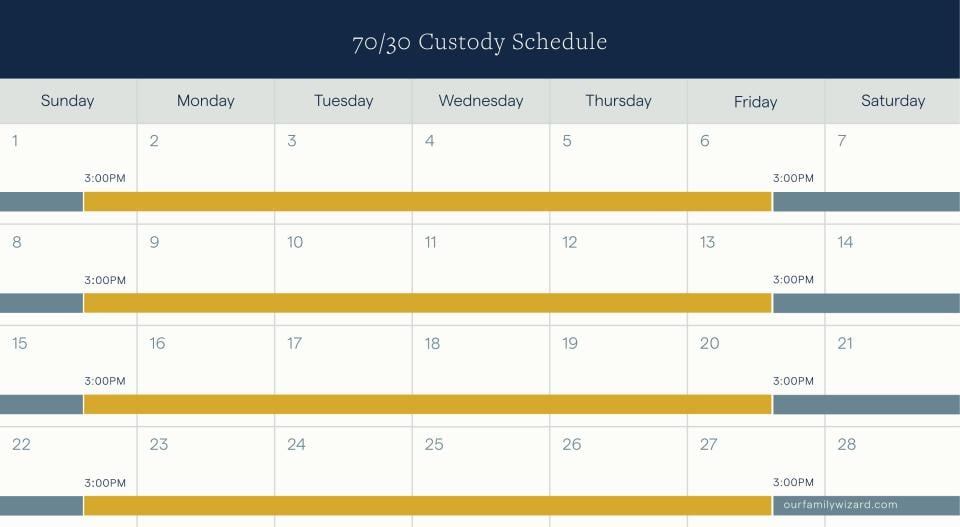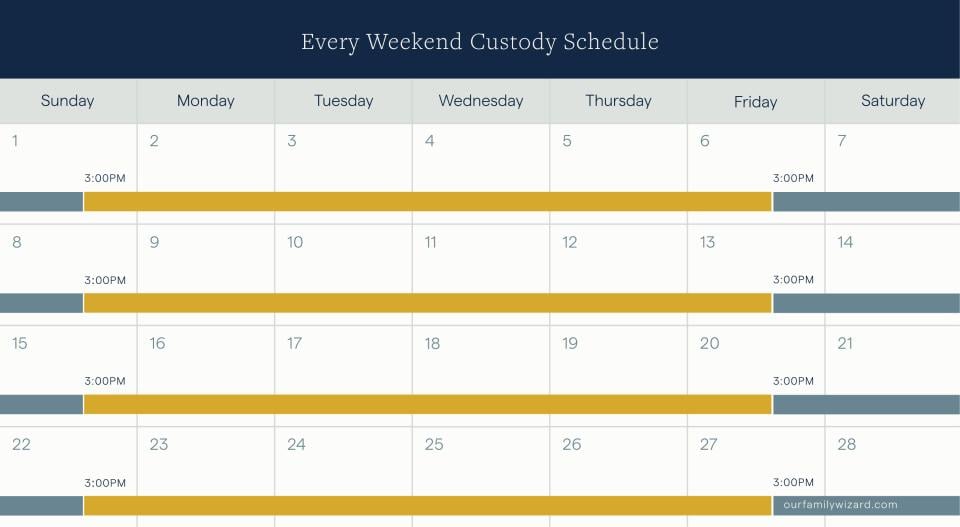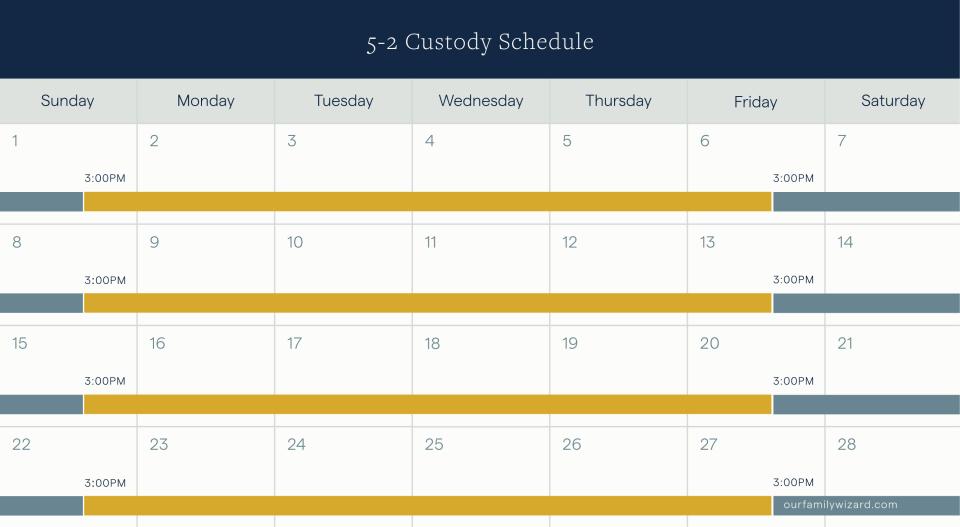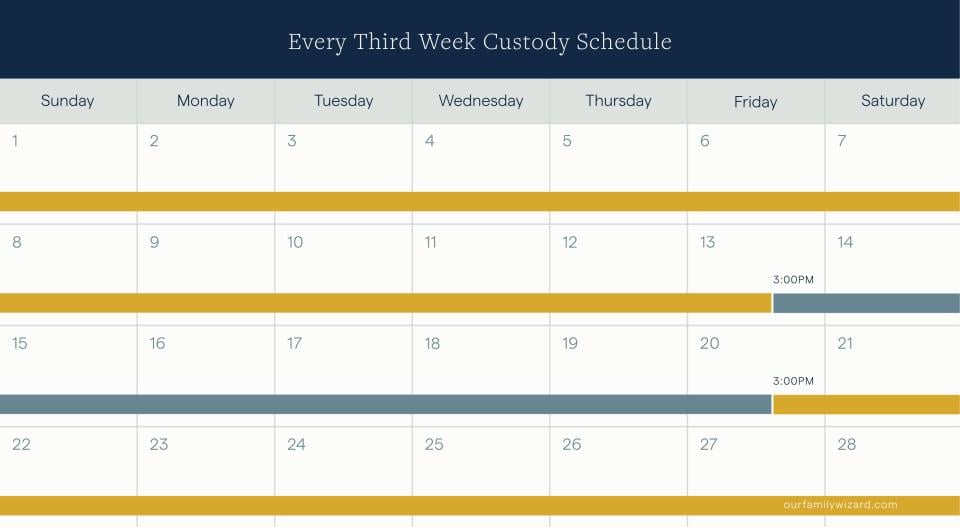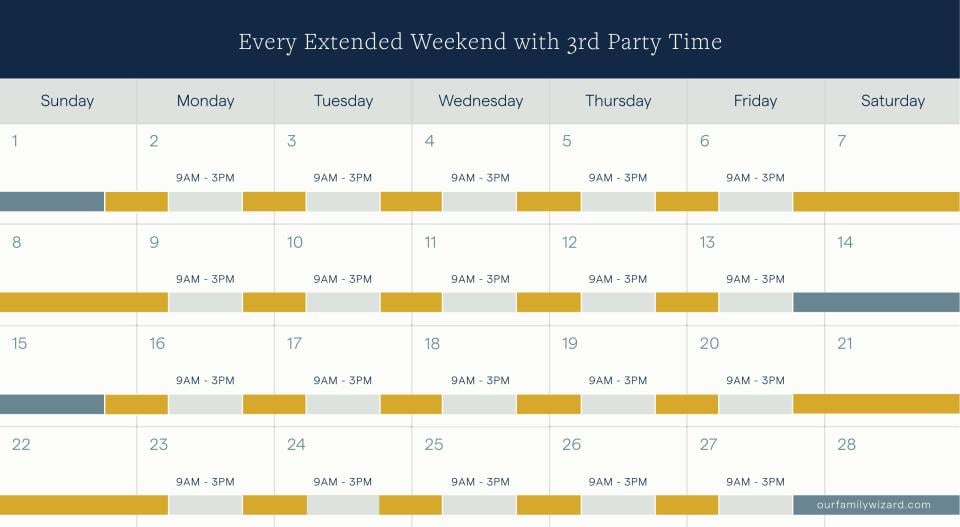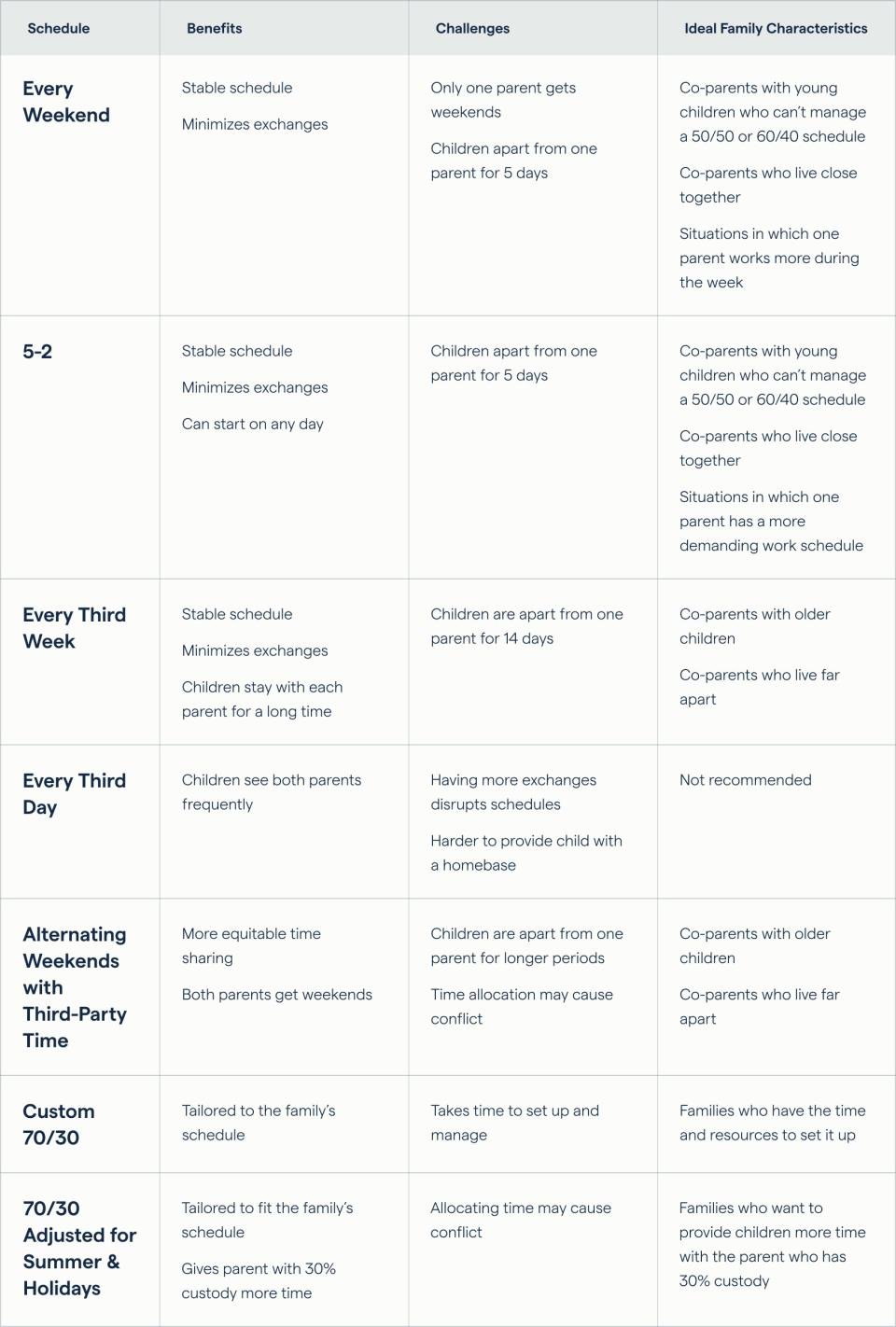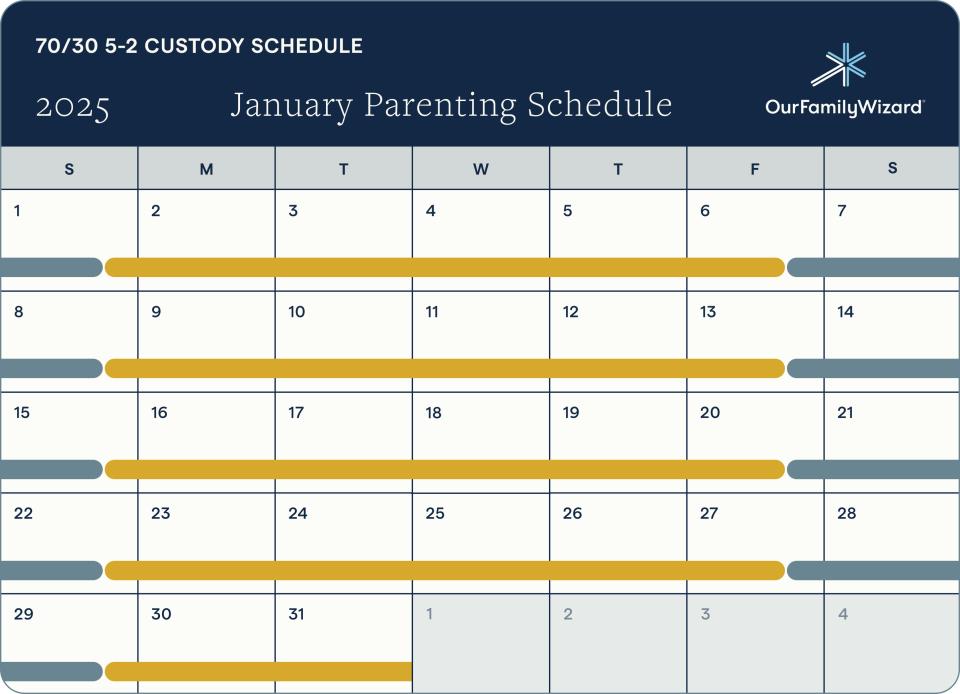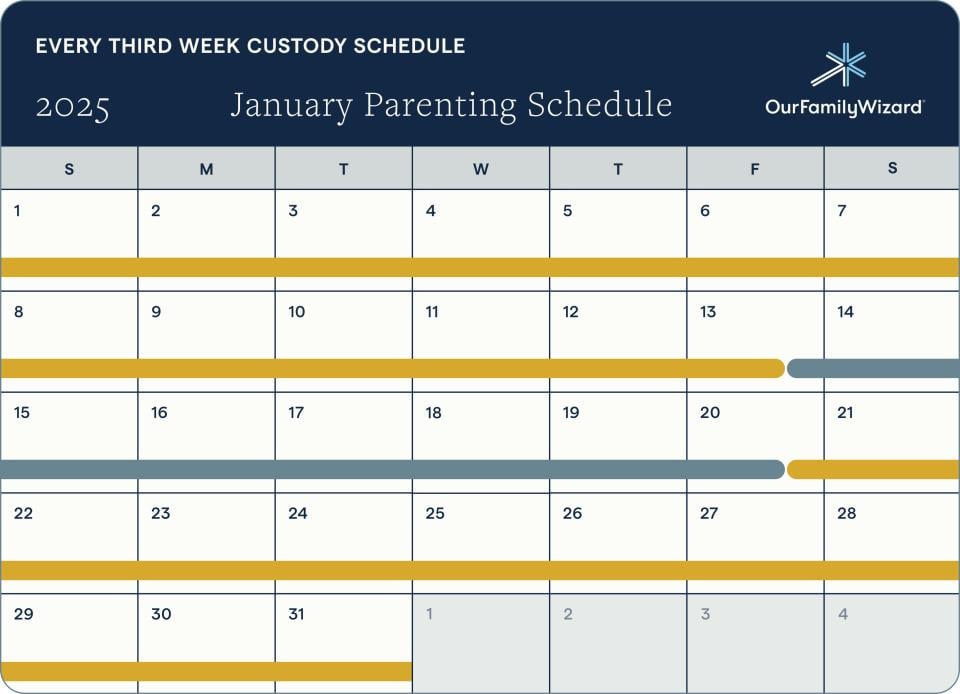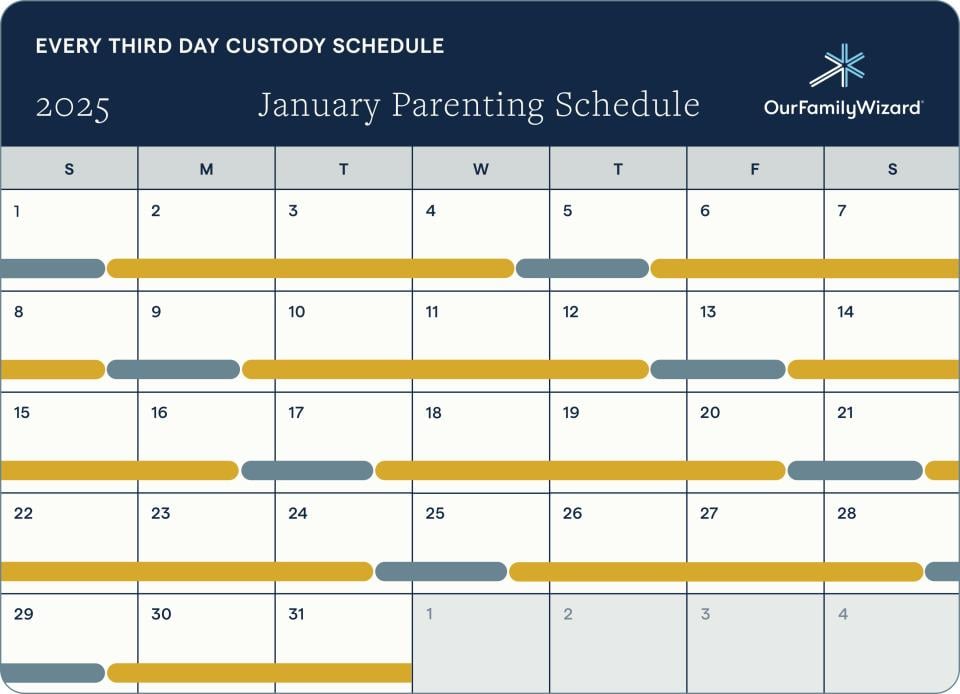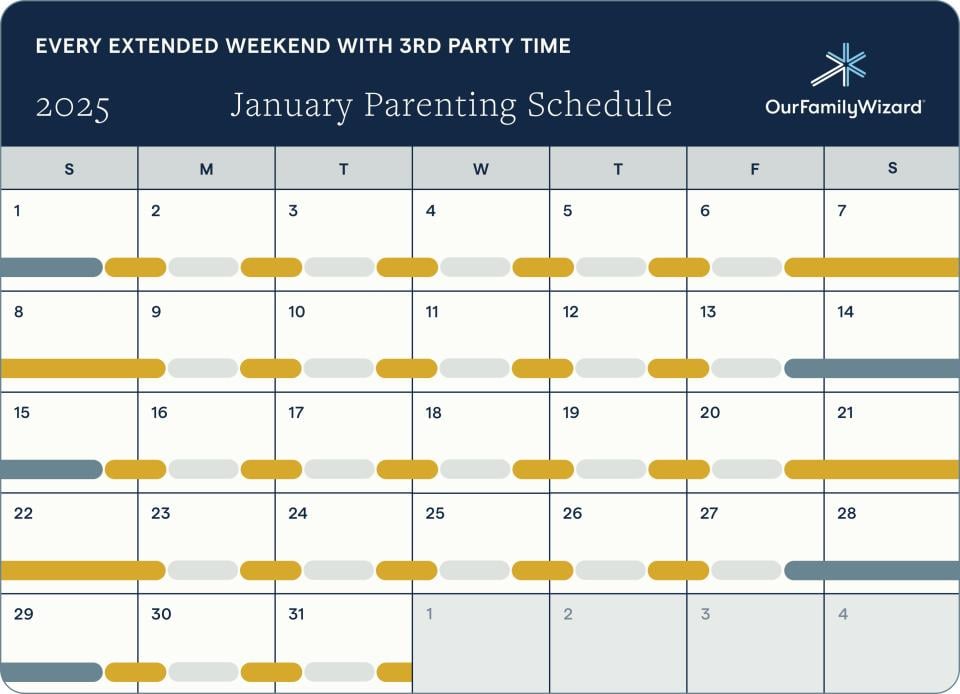70/30 Custody Schedules: Examples, Factors, and Expert Tips
Custody schedules lay the groundwork for effective co-parenting. Explore the pros and cons of the 70/30 plan, compare 70/30 against other schedules, and download free templates. Gain expert insight to determine if 70/30 suits your family’s needs.
What Is a 70/30 Custody Schedule?
A 70/30 custody schedule is a co-parenting arrangement where one parent has the child 70% of the time while the other has 30%. This schedule has become less common than others over the past 50 years.
A 70/30 custody schedule is an alternative to joint equal parenting schedules like 50/50 or 60/40 plans. In a 70/30 plan, one parent has substantially more time than the other parent. This can work well for families who cannot split time equally.
Many factors affect which schedule the co-parents select. Co-parents may start with one schedule and switch to another as circumstances change. In general, most co-parents hope to make a 50/50 custody schedule work. This joint custody schedule feels attractive because it tries to split parenting time down the middle, giving each co-parent equal parenting time. However, many co-parents can’t feasibly maintain a 50/50 schedule for various reasons.
“Some situations that prevent a 50/50 schedule are simply unavoidable,” says Family Law Attorney Samuel J. Berse. “For example, perhaps geographical distance or work commitments interfere with one parent’s ability to exercise 50/50 parenting time.”
Co-parents who can’t maintain a 50/50 tend to compromise with 60/40 split custody, which gives one co-parent primary physical custody with 60% of the co-parenting time. If the 60/40 split still creates logistical problems, co-parents may land on a 70/30 split.
“A 70/30 parenting time schedule, where one parent has two overnights every week, is a common arrangement designed to prioritize practicality over equal parenting time, especially when factors such as geographical distance or work commitments come into play,” Berse says.
Here's how Family Law Attorney Julie Colton describes the difference between schedules like 50/50 and 70/30:
“Primary physical custody is when a parent has more than 50% of the custodial overnights. Partial physical custody is when a parent has less than 50% of the custodial overnights. Therefore, a 70/30 custody arrangement would be a primary/partial custody arrangement. This means that one parent has primary physical custody, and the other parent has partial physical custody.”
Like Berse, Colton points out that the 70/30 schedule usually arises out of necessity. “Usually, co-parents take on a primary/partial schedule like 70/30 when they are dealing with logistical constraints. For example, when parents live more than 30 to 40 minutes from the child’s school, a shared custody schedule (50/50) is less practical.”
Colton adds that it is important to note that the physical custody schedule does not affect the legal custody arrangements, which designates decision-making responsibilities for a child. “Parents with a 70/30 physical custody schedule still usually have a shared legal custody agreement,” says Colton.
Although this schedule was popular in the 1970s, many experts don’t recommend it because it gives one co-parent significantly more time with the children. Also, the available 70/30 scheduling options can be difficult to implement.
 “Determining which parent should have primary physical custody of a child and what particular parenting time schedule should be implemented can be quite complicated in the light of life’s day-to-day variabilities,” says Family law attorney Peter Stambleck. “A straightforward implementation of a 70/30 child custody schedule would give the non-custodial parent two overnight visitations per week. This arrangement is imbalanced and not a true form of shared parenting. Clients very rarely agree to a 70/30 custody spilt, unless it is the most appropriate schedule to ensure that they continue to provide a lifestyle that is best for their child.”
“Determining which parent should have primary physical custody of a child and what particular parenting time schedule should be implemented can be quite complicated in the light of life’s day-to-day variabilities,” says Family law attorney Peter Stambleck. “A straightforward implementation of a 70/30 child custody schedule would give the non-custodial parent two overnight visitations per week. This arrangement is imbalanced and not a true form of shared parenting. Clients very rarely agree to a 70/30 custody spilt, unless it is the most appropriate schedule to ensure that they continue to provide a lifestyle that is best for their child.”
Still, the 70/30 may be suitable for co-parents who live far apart or for children who prefer having a consistent home base for much of the week. As with any parenting plan, the suitability of a 70/30 arrangement depends on how your family’s circumstances affect the realities of day-to-day life.
Stambleck puts it best: “Every family is different, and a child custody agreement needs to address the existing and anticipated needs of the family clearly and specifically. There are many factors to consider, including but not limited to the needs of the children, their ages, each co-parent’s availability, location, and other commitments that may affect the ability to care for the children.”
Key Takeaways
- A 70/30 custody schedule is a physical custody arrangement where one parent has the child for 70% of the time, and the other has the child for 30%.
- Factors such as geographical distance or work commitments can make a 70/30 schedule more practical for some families than a 50/50 or 60/40 schedule.
- A 70/30 schedule often involves a 5-2 split, where one parent has the child during the school week, and the other has weekends.
- When deciding on a 70/30 custody schedule, co-parents should prioritize the child's well-being while considering logistical factors like work schedules and geographic distance.
- Co-parents can use a dedicated app to track and manage 70/30 custody schedules.
What Does a 70/30 Custody Schedule Look Like?
Co-parents with a 70/30 schedule usually split the week with a 5-2 schedule where one co-parent has the child for the school week, and the other takes weekends. Alternatives include swapping every third week or having more frequent exchanges every third day.
Berse describes the 70/30 parenting schedule like this: “A 70/30 parenting schedule involves one parent having two overnights per week (equivalent to 104 overnights per year), while the other parent has five overnights a week (260 overnights per year). Typically, co-parents divide this arrangement where one co-parent has the children during the school week and the other co-parent has them either every other weekend or most weekends (such as three weekends per month or four weekends per month in months with five weekends). Additionally, many co-parents allocate extra time during the summer for the parent with 30% custody.”
“A partial physical custody schedule is often every other weekend from Friday after school until Monday start of school, along with some weekday time,” says Colton. “The time during the week may be an overnight on the non-weekend week or an overnight each week. The weekday time may just be a few hours for dinner.”
Experts recommend mapping out a 70/30 schedule in two-week blocks. Dividing 14 days into a 70/30 split means the co-parent with 70% custody should receive around ten days and nights, and the co-parent with 30% should receive the remaining four days and nights. This approach gives co-parents a broad view of the schedule and allows for easy comparison between 70/30 and other common custody schedules.
For the parent with 30% custody or partial custody, Colton adds that some situations require that time to be supervised. “Where there is an issue with a substance use disorder or untreated mental health issues that cause a risk the child, then there may be a need for supervised custody.” She adds that this may be a temporary solution: “A parent who is addressing issues of substance use disorder and/or untreated mental health problems that are negatively affecting the child may find themselves with a partial physical custody schedule while any safety concerns for the children are being addressed.”

70/30 vs. 60/40 Custody Schedules
In a 70/30 custody schedule, one parent has the child about 70% of the time, while the other has them 30%. In a 60/40 plan, one parent has the child 60% of the time, and the other parent has them 40%.
In a 14-day block, a 60/40 custody schedule typically allocates eight days to the co-parent with 60% custody and six days to the co-parent with 40% custody. 60/40 parenting plans often use a 3-4 weekly schedule, alternating custody in four-day and three-day blocks.
On the other hand, a 70/30 split provides the parent with primary custody with significantly more time with the children. Instead of a 3-4 weekly schedule, a 70/30 split typically utilizes a 5-2 split variation.
Berse says co-parents often adopt the 70/30 parenting schedule by necessity, typically due to the work schedules. "A 70/30 schedule is commonplace when it's simply not feasible for one parent to have weekday overnights during the children's school year,” he says. “Co-parents usually adopt this schedule because it's practical.”
70/30 vs. 80/20 Custody Schedules
A 70/30 custody schedule involves one parent having the child 70% of the time while the other parent has them 30% of the time. An 80/20 custody schedule means one parent has the child 80% of the time while the other parent has them 20% of the time.
In a 14-day block, an 80/20 custody schedule allocates 11 days to the co-parent with 80% custody. It is common for co-parents to follow an assigned weekend custody schedule, where the child spends pre-determined weekends each month with the non-custodial co-parent.
In the 80/20 arrangement, the primary custodial parent assumes 80% of the parenting time, representing a 10% increase over the 70/30 plan. The decision between the two plans depends on the co-parents’ circumstances and the child’s best interests.
Examples of 70/30 Custody Schedules
The most common 70/30 custody schedules include the 5-2, every-third-week, and every-third-day schedules. Co-parents can also make custom 70/30 schedules that account for third-party time and change schedules during holidays or the summer.
Here’s a summary of the different 70/30 custody schedules.
Every Weekend Custody Schedule
In the every-weekend custody schedule, the child will spend every weekend with the co-parent with 30% custody. Then, they will spend the school week with the other co-parent. Co-parents typically keep Fridays and Sunday afternoons as exchange days. This schedule is the most common variation of the 5-2 split.
The every-weekend schedule works well when one co-parent has demanding weekday schedules or work commitments. This schedule provides stability and routine for the child. However, it may create conflict because only one co-parent will have weekend time.
5-2 Custody Schedule
In the 5-2 schedule, the co-parent with 70% custody has the child for five days, and the co-parent with 30% custody has the remaining two days. When co-parents start this schedule on Sunday night, the primary custodial parent has the school week until Friday when their child goes to school, so the schedule becomes the every-weekend schedule.
Co-parents can start the 5-2 schedule on any day. This schedule provides routine and consistency for the child and reduces transitions. Also, co-parents can align this schedule to work best with work or school commitments. However, co-parents may find themselves in conflict over allocating weekend time.
Every Third Week Custody Schedule
In the every-third-week custody schedule, the child spends two weeks with the 70% co-parent, followed by one full week with the other co-parent. This arrangement can be suitable for parents in long-distance co-parenting situations or those with unique circumstances that call for extended periods with each parent. This schedule also minimizes transitions for the child and can contribute to a sense of stability.
However, the extended time apart may pose challenges in the relationship between the child and non-custodial co-parent.
Every Third Day Custody Schedule
An every-third-day custody schedule, where the child transitions between co-parents every third day, provides frequent and consistent contact with both parents. This arrangement works best for parents who live close to each other and have flexible schedules. The benefits include regular involvement of both parents in the child's life, maintaining a strong bond with each co-parent, and reducing the sense of separation. However, challenges may arise with the increased transitions, potentially impacting the child's sense of stability and routine and logistical considerations for both co-parents. Most experts do not recommend this arrangement because it is disruptive and doesn’t provide the child with stability or a routine schedule.
Custom 70/30 Custody Schedules
Co-parents have the flexibility to design a personalized 70/30 plan that caters to their unique circumstances. One approach is to divide a 14-day period, allowing the 70% co-parent to have any ten days while the 30% co-parent takes four days. This customization empowers parents to seek a balance that aligns with their situations, fostering a healthy co-parenting dynamic. By tailoring the schedule, co-parents can ensure a structure that supports the well-being of their children while accommodating their own needs and responsibilities.
“One of the major disadvantages of a 70/30 parenting schedule is that one parent has substantially more time with the children,” says Stambleck. “Co-parents can make this plan more balanced by adding additional parenting time during holidays, vacation time, school break, and during the summer.”
The following schedules factor in third-party time, holidays, and summer into the 70/30 plan.
Alternating Weekends (Considering 3rd-Party Time) Custody Schedule
Alternating weekends give 70% of custodial parents every other weekend, plus the weekdays. Co-parents can also calculate the 70/30 split based on their time with the child, excluding third-party time spent with teachers or caregivers. Accounting for the third-party time can grant the 70% co-parent an additional weekend, reinforcing the 70/30 split.
70/30 Plans that Account for Holidays and Summers
Some co-parents opt for a more flexible approach to parenting schedules during summer breaks, holidays, or vacations. During these periods, co-parents may intentionally allocate additional time to the 30% co-parent. This thoughtful consideration allows the children to have more quality time with the 30% co-parent, helping to address any imbalance from regular weeks and fostering a stronger relationship between the child and the 30% co-parent. This adaptable approach requires that co-parents spend more time tailoring their schedule but promotes a healthier co-parenting dynamic and prioritizes the well-being of the children.
70/30 Custody Plan Pros and Cons
Factors to Consider When Choosing a 70/30 Parenting Schedule
When choosing a 70/30 parenting schedule, it is crucial to consider significant factors that may affect how the plan works. For example, consider the child's age and needs, the distance between co-parents, the parents’ work schedules, and the level of conflict between co-parents.
A standardized custody agreement won’t accommodate the diverse circumstances and preferences of different families. A personalized approach, where co-parents work together to understand and adapt to specific circumstances, is essential in selecting the right parenting schedule.
Choosing a custody schedule involves multiple factors, which can cause conflicts. For example, co-parents of a young child might lean toward a 5-2 plan to foster regular interactions. However, if they live far apart, implementing a 5-2 schedule can present logistical obstacles. In making these decisions, the child’s well-being must always take precedence.
While there is much to consider when evaluating custody arrangements, here is breakdown of four key factors to consider before choosing 70/30 schedule:
- Child’s age
The child’s age plays a significant role in determining the time they require with each co-parent. Contemporary attachment theory underscores the crucial influence of secure parent-child relationships on a child's emotional and psychological development. Extensive research consistently highlights the necessity for children to have sufficient and consistent contact with both co-parents to form healthy relationships.
For instance, a seminal review from 2004, Adolescent-parent attachment: Bonds that support healthy development, underscores the importance of secure attachment with both parents. The paper emphasizes that just like in early childhood, secure attachment in adolescence profoundly impacts development, fostering exploration and the development of cognitive, social, and emotional competence. These findings emphasize the significance of maintaining strong bonds with both parents throughout a child's development to support their overall well-being and optimal growth.
A 5-2 schedule or every-third-day plan is the best option for younger children who will benefit from regular interactions with both parents. Teens and pre-teens will likely prefer the 5-2 or every-third-week schedule. - Physical distance
The physical distance between co-parents is another crucial factor when deciding between 70/30 custody schedules. The proximity of the co-parents' residences can significantly impact the feasibility of a parenting schedule.
If co-parents live apart, frequent household exchanges can be stressful for the child and co-parents. Depending on the distance, the 5-2 schedule and every-other-week schedules can work. For example, if co-parents live an hour apart or more, even the 5-2 schedule may prove to be too stressful. - Parent’s work schedule
Co-parents need to evaluate their work commitments and determine how it aligns with the proposed schedule. Work schedules that involve long hours, frequent travel, or irregular shifts can pose challenges in maintaining a consistent custody arrangement.
For example, if one co-parent has a demanding work schedule during specific, consistent days of the week, the co-parents can shift the schedule so the parenting days fall on days off from work. For example, the 5-2 schedule can work very well if the co-parent with 70% custody has a flexible working week. Then, the co-parent, with a demanding weekly schedule, will have the children on the weekends. Of course, co-parents can change the day that the 5-2 starts to accommodate different or unconventional work schedules. - Child’s school schedule
Finally, co-parents should evaluate how a 70/30 schedule will affect their children’s school commitments. During the school year, the 70/30 schedule should promote a consistent routine that allows the child to focus on school and extracurricular activities. For example, every third day schedule doesn’t work well during the school week (unless the co-parents live very close to one another) because the child will have to juggle schoolwork with exchanging households.
Also, co-parents may want to ensure they both can attend school events, parent-teacher conferences, or extracurriculars.

How to Pick the Best 70/30 Custody Schedule for Your Family
When selecting a 70/30 schedule, consider your child’s age, the distance between co-parents, work schedules, and school commitments. Be sure to prioritize your child’s well-being, and ask them for input.
Here's a quick checklist of questions to consider when determining if a 70/30 custody schedule would suit your family. Remember that your child's best interests should always be the primary guiding consideration.
- Child's age: How old is your child, and what are their specific needs regarding regular interactions and stability? Will a 70/30 schedule provide sufficient quality time with each parent for your child?
- Child’s well-being: How will a 70/30 schedule affect your child?
- Distance between co-parents: How far apart do you and the other co-parent live? Will frequent exchanges be manageable?
- Work schedules: Do both co-parents have work schedules that allow consistent and reliable parenting time? Are there any irregular shifts or travel involved that could pose challenges?
- Child's school schedule: Will the proposed custody schedule support the child's academic commitments and extracurricular activities? Can both co-parents be available for school events and parent-teacher conferences?
- Level of conflict: How well do you and your co-parent communicate and cooperate? Is there a significant level of conflict that could affect the custody schedule?
- Child's preferences: Have you considered the child's preferences and desires regarding the custody schedule? How involved do they want to be in shaping their own schedule as they grow older?
Simplify your 50/50 custody schedule
Keep your co-parenting organized with OurFamilyWizard.
Personalize your 70/30 custody schedule to serve your family’s situation best. Use our 70/30 custody schedule templates to visualize how a schedule will work for your family.
Download your customizable 70/30 5-2 (or every weekend) custody schedule
Easiest Way to Track 70/30 Custody Schedules
Take control of your co-parenting schedule with OurFamilyWizard. This powerful co-parenting app offers comprehensive tools for co-parents looking for an easier way to manage their custody schedule.
“The OurFamilyWizard Calendar feature easily accommodates the 2 out of 7 nights, 70/30 parenting schedule, and also supports custom 70/30 plans,” notes family law attorney Stambleck.
A standout feature is the schedule change request tool. With just a few clicks, co-parents can easily communicate about schedule adjustments. Schedule change request helps parents propose a day swap, request a change in parenting time, and respond to requests from the other parent. When a request is approved, the schedule updates automatically—no need to manually enter adjustments.
OurFamilyWizard’s dedicated platform tailored for co-parents offers a practical solution to enhance and streamline the co-parenting dynamic. With it, you'll experience a newfound level of organization and efficiency in managing your custody schedule.
70/30 Co-Parenting Schedule FAQs
Explore frequently asked questions about 70/30 custody schedules. Learn how this split affects child support, whether it's considered joint custody, and how to handle school and extracurriculars. The goal is providing stability, consistency, and a supportive environment for the child.
Why is a 70/30 split so popular?
A 70/30 split is less common than 50/50 or 60/40. But for parents who live far away from each other or have scheduling challenges, such as a busy work schedule, a 70/30 custody split can be a helpful solution.
What age does a 70/30 custody schedule work for—toddlers, school-aged children, or teens?
Younger kids need frequent interaction with both parents, so consider a 5-2 schedule or every-third-day plan. Teens and pre-teens benefit from fewer changeovers, so their busy lives are disrupted less. But it could work for any ages, depending on family circumstances.
How does a 70/30 split affect child support?
In a 70/30 split, the parent with 30% parenting time will typically pay more child support than they would with a 60/40 split or a 50/50 split. But the exact difference depends on many complicated factors, including both parents’ incomes.
Is a 70/30 split a good custody schedule?
70/30 can be tricky. The 5-2 pattern, which splits the school week and the weekend, can lead to resentment. The every-3rd-day plan is disruptive. The every-3rd-week pattern means the child doesn't see one parent for two whole two weeks.
Still, the 70/30 split is sometimes the best fit for a family that has complicated scheduling needs. The most important thing is consistency and stability.
How do you get a 70/30 split?
Judges will usually only grant a 70/30 split for one of two reasons. Either both parents agree, or one parent successfully demonstrates that the parent getting 30% wouldn’t be able to care for the children during additional time.
Is a 70/30 split considered joint custody?
Usually, yes. If you have joint physical custody with a 70/30 split, the parent with 70% has primary physical custody, and the other parent has partial custody. A parent with sole custody can choose to let their co-parent have 30%.
To break it down even further, you could have sole legal custody (the right to make important decisions about your child's life) along with joint physical custody. Or you can share both legal and physical custody.
Is a 70/30 custody split best for my child?
It's usually best for a child to have somewhat equal time with both parents, but when that isn't easy to manage or isn't wise, a 70/30 split can still give your child predictability, stability, and time with both parents.
How can you juggle school and extracurricular activities with a 70/30 custody schedule?
For school-aged children with a 70/30 custody schedule, a 5-2 pattern can help. It separates the school week from the weekend, making it easy for one parent to manage after-school activities and the other parent to handle weekend extracurriculars consistently.
Does 70/30 custody hurt the child’s relationship with either parent?
It’s healthy for children to spend time with each parent, but you can’t always split it equally. 70/30 custody doesn't necessarily hurt the children's relationship with either parent, especially if both parents are active and engaged during their parenting time.
In fact, quality time can be just as important as quantity. When both parents make the most of their time together, the child can maintain strong, healthy relationships with both.
A Note on Terminology
In general, the term “physical custody” refers to which parent a child lives with. Today, many experts use other terms to describe this arrangement, like “parenting schedule” or “parenting time arrangement.” These new terms better represent a relationship and the parent’s responsibilities for their children. But just a heads up: this article uses these older and newer terms interchangeably.

